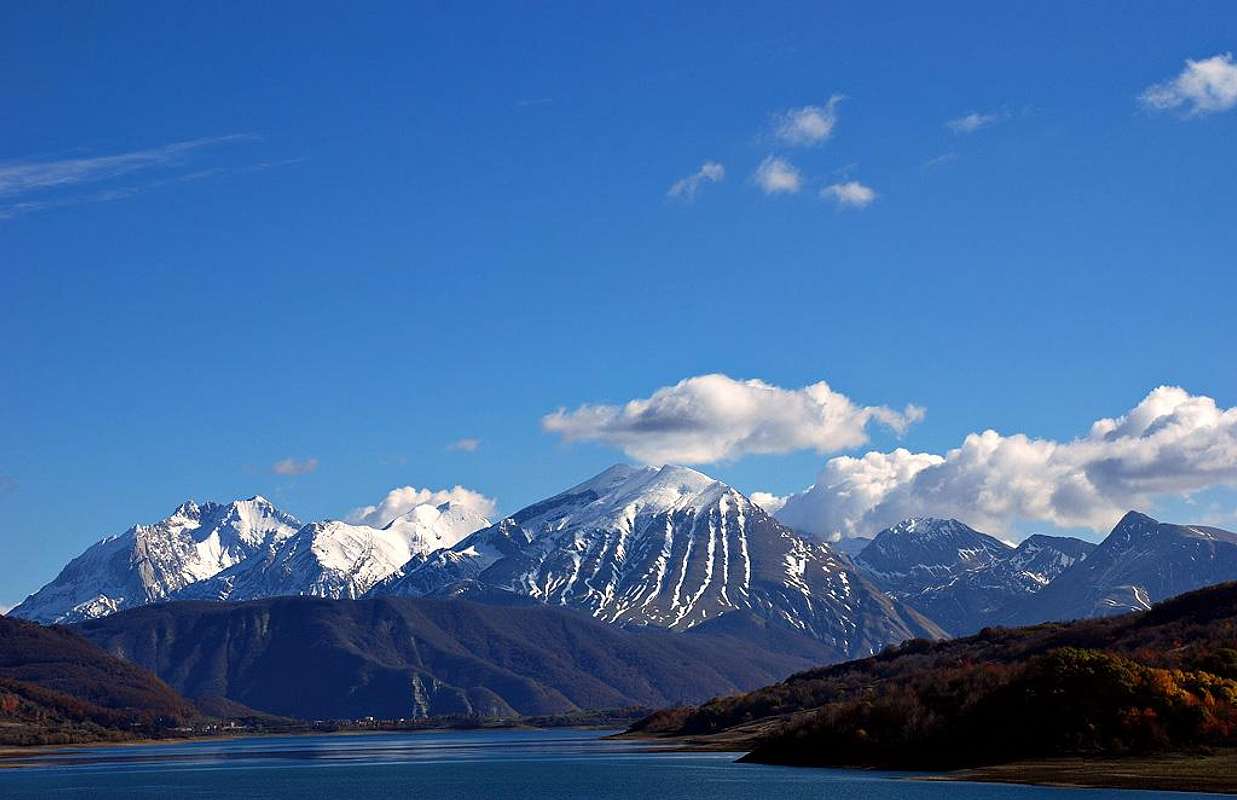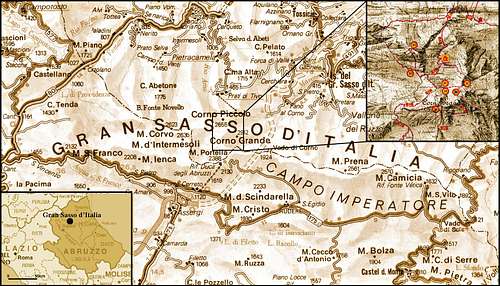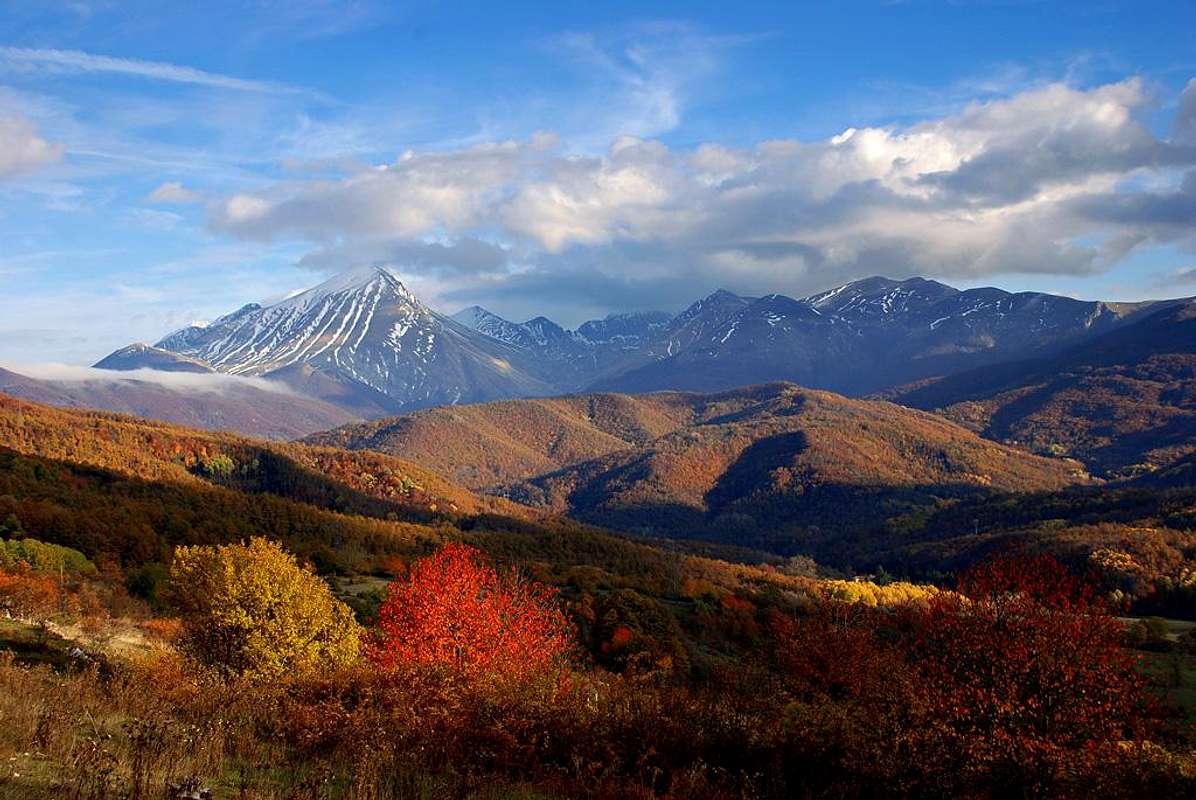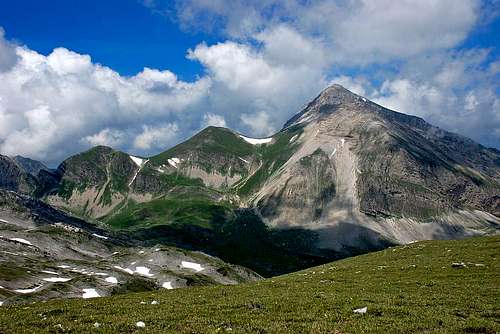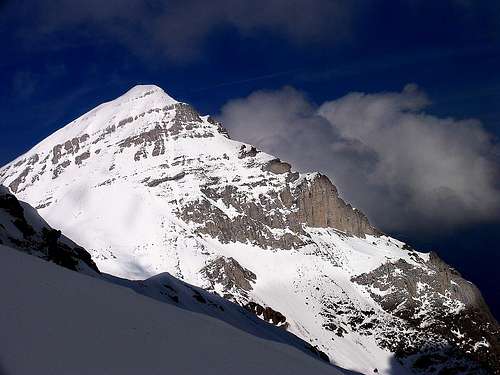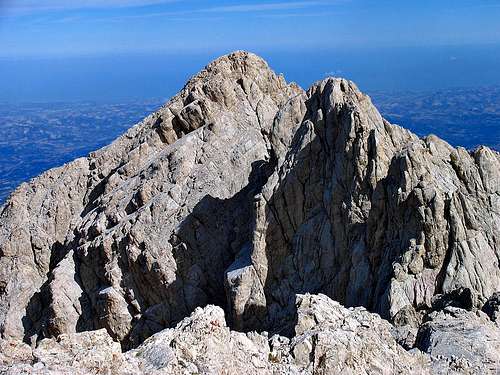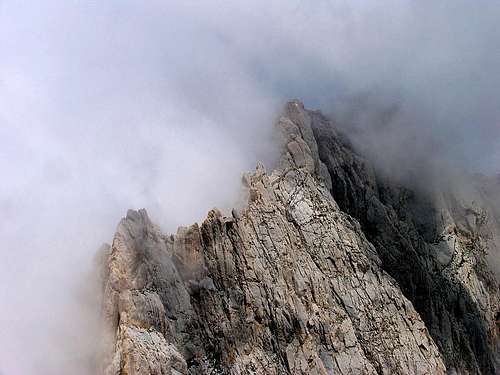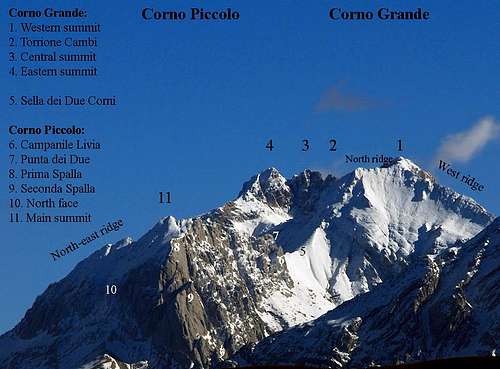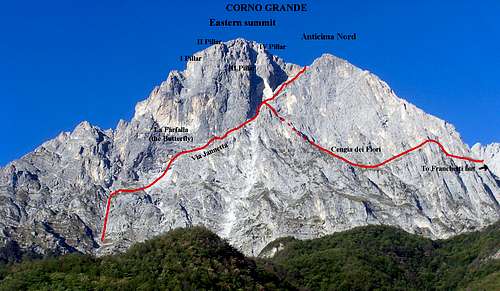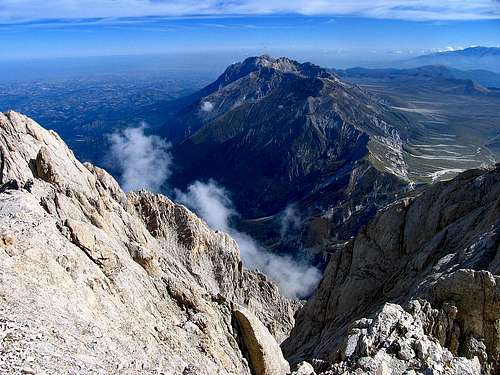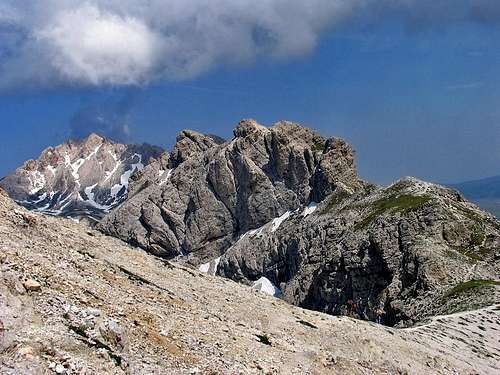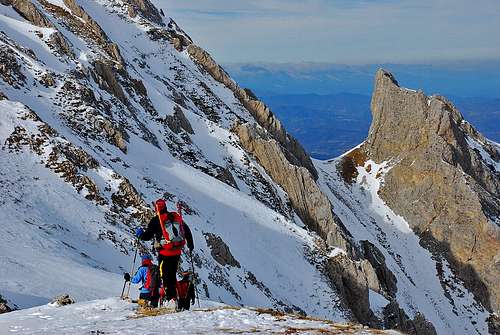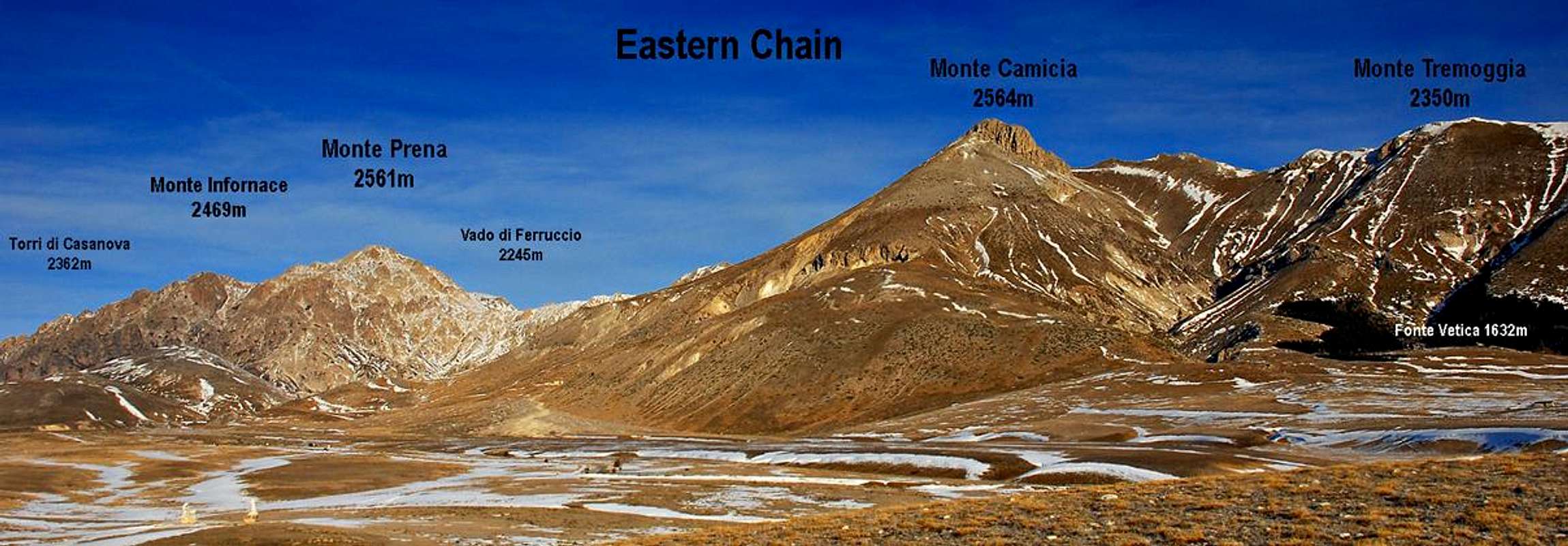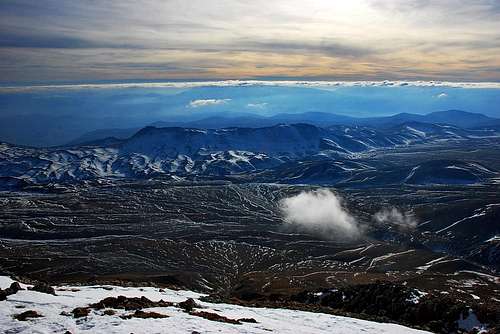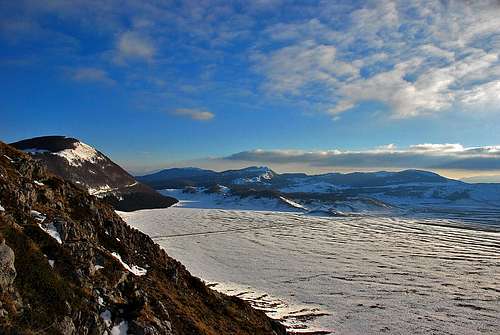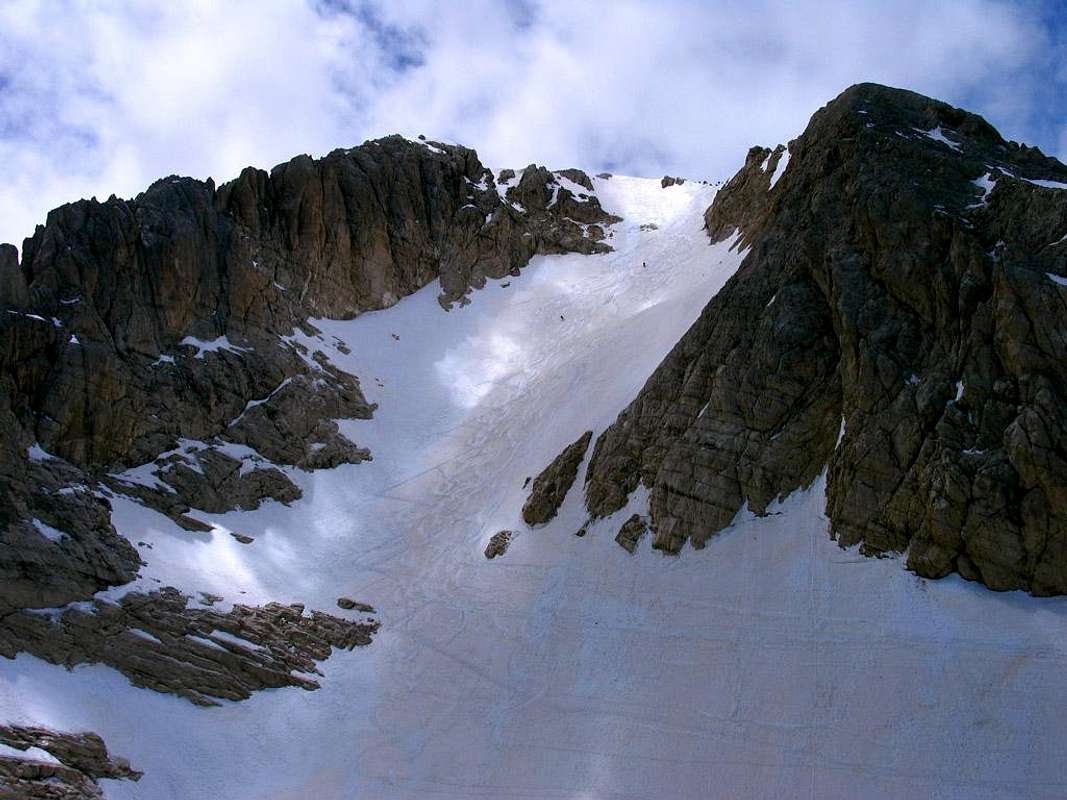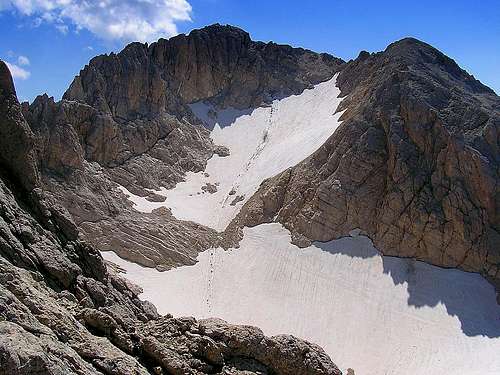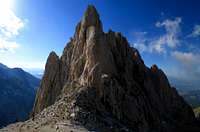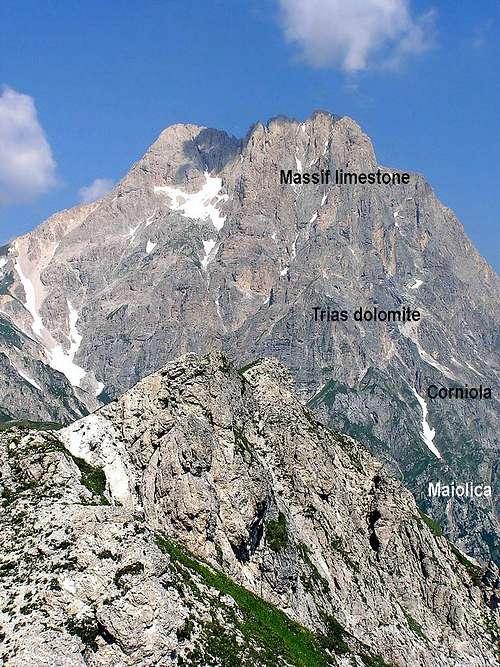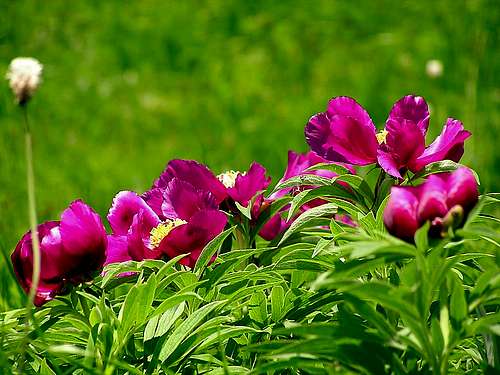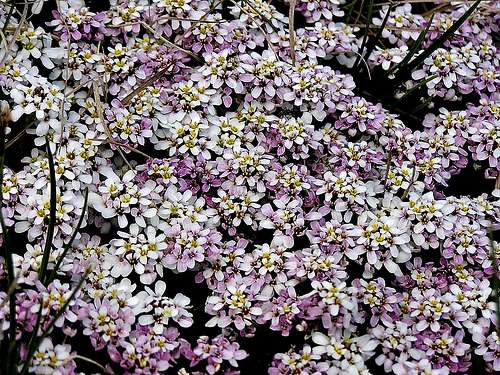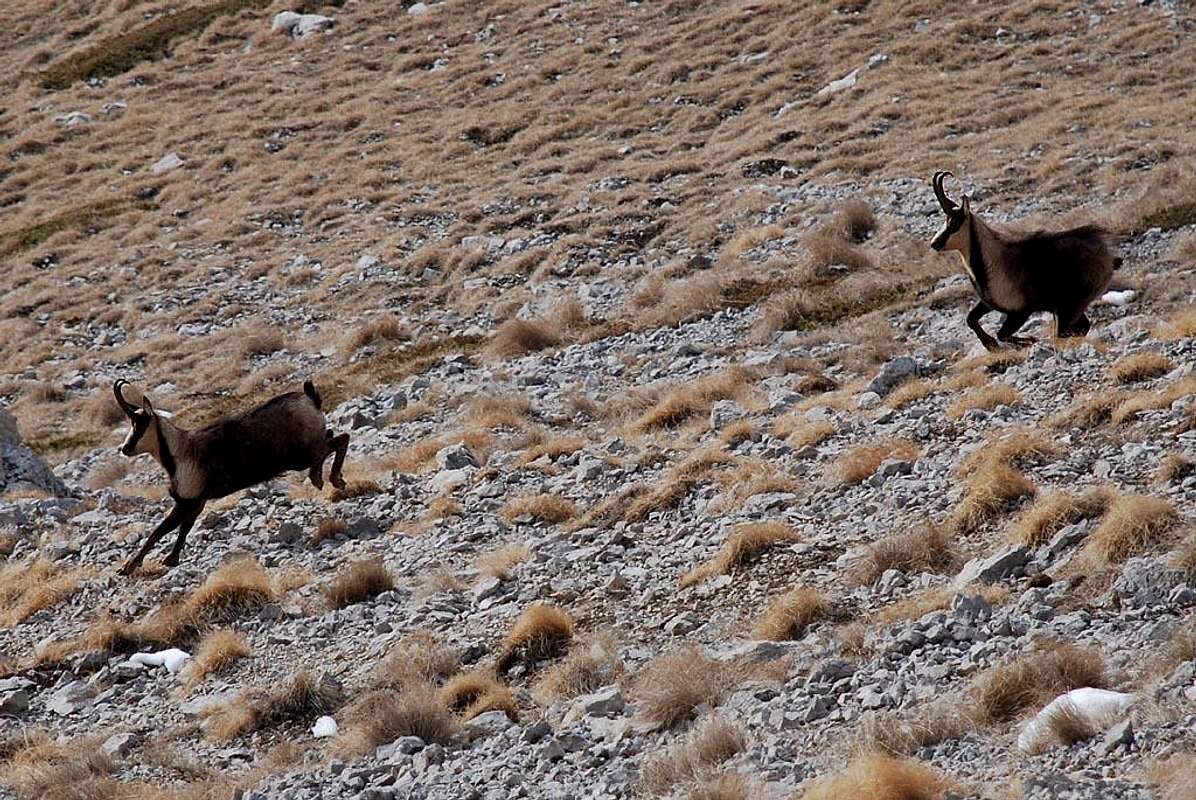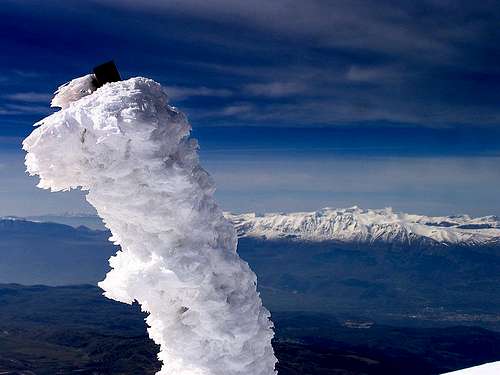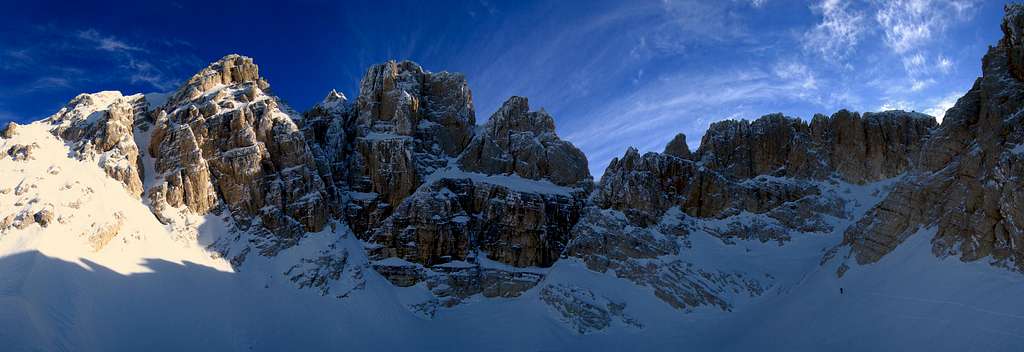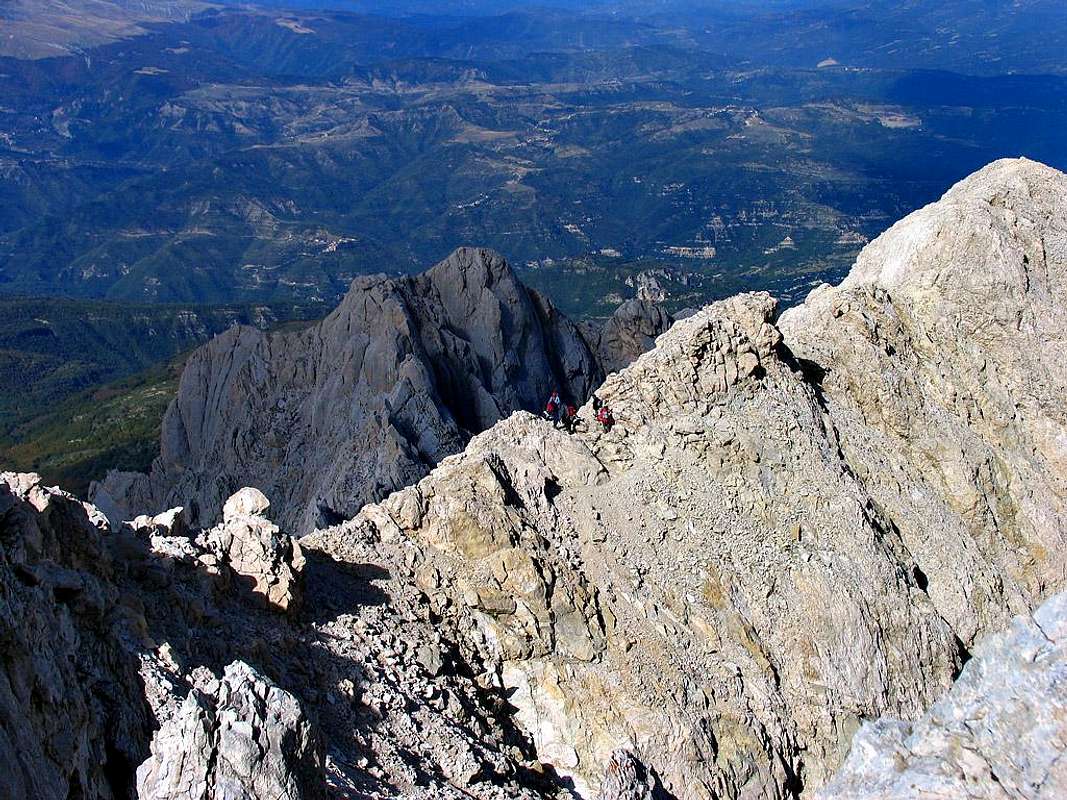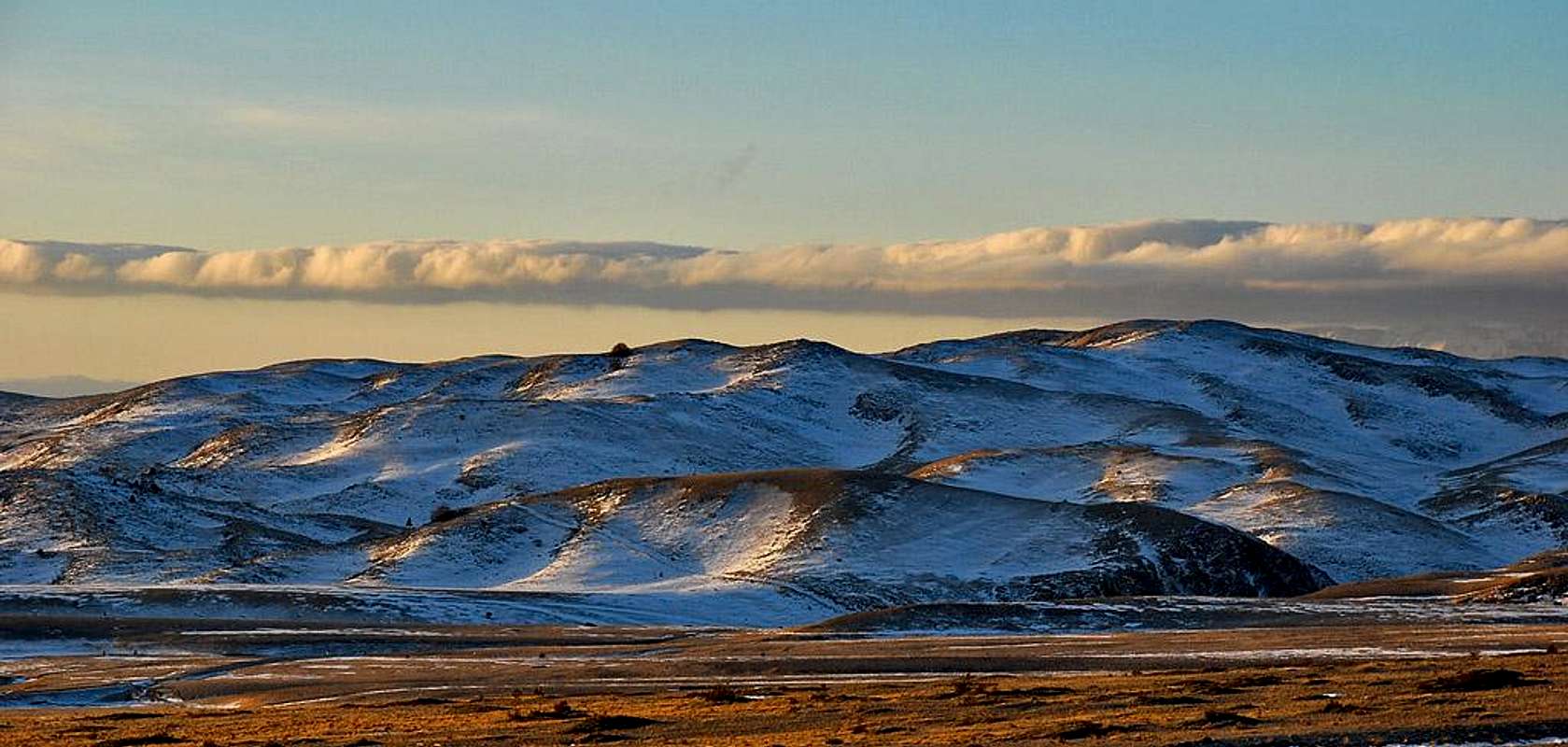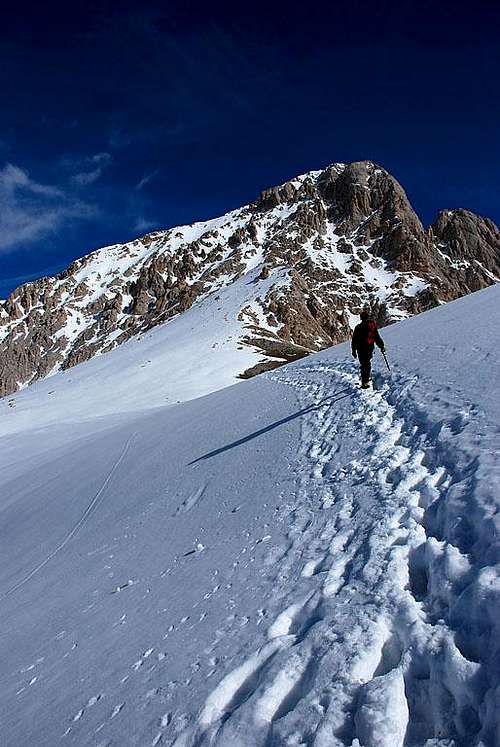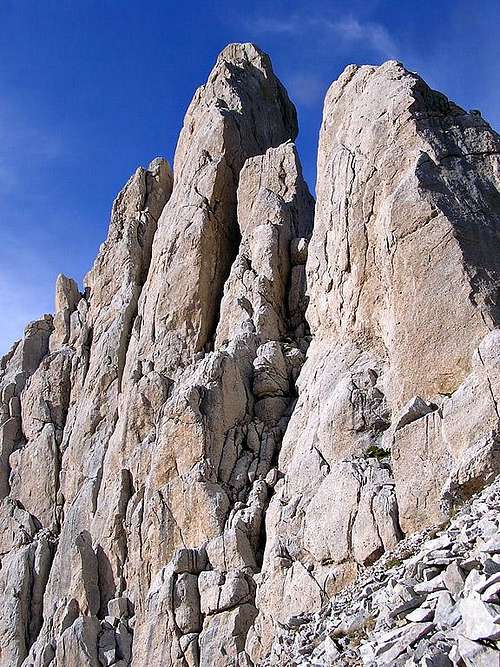|
|
Area/Range |
|---|---|
|
|
42.47000°N / 13.57000°E |
|
|
Hiking, Mountaineering, Trad Climbing, Sport Climbing, Bouldering, Ice Climbing, Aid Climbing, Big Wall, Mixed, Scrambling, Via Ferrata, Canyoneering, Skiing |
|
|
Spring, Summer, Fall, Winter |
|
|
9554 ft / 2912 m |
|
|
What's new
- 19th of march 2011: updated historical section
- 13th of october 2009: embedded the footage from the movie "Gran Sasso, la montagna che unisce"
- 2nd of february 2008: great exploit on Monte Camicia north face! The 28th of january 2008, Andrea Di Donato, instructor of Paolo Consiglio Mountaineering school of Cai-Rome, did the first winter ascent in free-solo of Monte Camicia North face! The difficulty of this climb (Marsili-Panza route) doesn’t lie as much in the thecnical difficulties (V UIAA), but rather in the lenght of the route (2000m of development and 1250m of vertical gain) and in the very bad quality of the rock. This is, in my opinion, true mountaineering!
Some links (in italian): tuttoabruzzo.it; Primadanoi.it; Montagna.tv; IntoTheRocks - 16th of january 2008: Added wonderful as's panorama pictures in the Panorama and sceneries section
- 24th of november 2007: Added several weblinks in the concerning section
- 20th of november 2007: Added the amazing Velebit's photo of Gran Sasso range seen from Croatia, in the sub-chapter "Gran Sasso from distance"
- 17th of november 2007: Gran Sasso range is on line!
Introduction: a mighty Giant in the centre of Italy
An ancient tale tells that many years ago Gran Sasso was a big sleeping giant... I don’t know if it’s the truth, but sure today Gran Sasso is the Giant of Appennines, a big mountain chain visible from all the summits of Central Italy and from the central Adriatic coast. With its high faces of rock and wide pastures, its sharpen ridges and deep valleys, its long-lasting snows and fresh woods, Gran Sasso is the “more alpine” mountain of whole Appennines: in Cornacchie Valley, in Maone Valley, near Vado di Corno and in many other places, you could believe to be in Dolomites... But Gran Sasso has its own peculiarity: it has a particular charm that makes this mountain range unique.
I think that also who knew the Dolomites, or Mont Blanc, or Matterhorn, or whatever great mount all over the world, could enjoy this fascinating mountain...
Before I start the description, I wish to make a thought: nowadays, Gran Sasso it’s a great “playground” for all the hikers, mountaineers, skiers of central Italy, a real piece of wilderness far from Rome only 1 hours ½ by car. Thousands people a year come there to have fun, but until 70 or 80 years ago these mountains were only an harsh place for its inhabitants. These rough mountain dwellers were mainly shepards (it seems that during XVII century, more than 2,000,000 of sheeps pasture on the meadows of Gran Sasso!), but also hunters or wool-sellers; they hardly lived and died between these mountains, and often they were forced by famine to leave their towns, seeking their fortune in far countries. Remember their history, when you hike or climb in these places...
Geographical overview
Gran Sasso d’Italia is situated in the Central Apennines, in the Abruzzo region (at east of Rome).
It’s the highest range of the whole Apenines and, consequently, its highest summit is the top of peninsular Italy (only Alps, in the north, and Etna Volcano, in Sicily, are higher, but they don’t belong to the peninsula).
Gran Sasso is situated in the north-east part of Abruzzo, within the provinces of Teramo, L’Aquila and Pescara. Central Apennines is formed by three parallel chains of mountains, with north-south orientation: Gran Sasso is placed in the eastern one.
Unlike the others mountain range of Central Appennines, that have an orientation north-south, Gran Sasso has an orientation east-west. Following the partition adopted by L.Grazzini and P.Abbate in their Cai-TCI guide “Guida ai Monti d’Italia – Gran Sasso d’Italia”, we can branch Gran Sasso range in three parts: the Western Part, the Central Massif, the Eastern Chain.
The Western Part starts from the Capanelle Pass (1300 m), on the border between the provinces of L’Aquila and Teramo, and is composed of three sub-parts: the Southern chain, Monte Corvo Massif in the north-west, and the Pizzo d’Intermesoli Massif in the north-east.
The Central Massif includes the highest summit of the range: Corno Grande (2912 m) and Corno Piccolo (2655 m), the more alpinistic mountain of whole Appennines chain.
The Eastern Chain starts from Vado di Corno Pass (1924 m), on the border between the provinces of L’Aquila and Teramo, and ends at Vado di Sole Pass (1621 m), on the border between the provinces of L’Aquila and Pescara. On its southern side, lies the fascinating plateau of Campo Imperatore.
Further south, within the Pescara province, we can include in the Gran Sasso range some lower mountains placed between Forca di Penne and Pòpoli Gorge.
Western Part
We can split the Western Part in 3 sub-parts: the Southern Chain, the Monte Corvo Massif, the Pizzo d’Intermesoli Massif.
From Capanelle Pass starts, with a grassy ridge, the Southern Chain: this chain has an orientation west-east, and presents a southern side steep and bare, while the north side is more complex, with deep and wide valleys, covered by beautiful woods at the middle-low altitude. The first important summit we find from west to east is Monte San Franco (2132 m), a green and mild mount. At west of it, lie Monte Jenca (2208 m) and Pizzo di Camarda (2332 m), a beautiful and sharpen summit. Succeds to them Cima delle Malecoste (2421 m).
On east of Cima delle Malecoste, there’s the triangular-shaped Pizzo Cefalone (2533 m), the higher summit of this sub-part and an interesting mountain, with a beautiful rock-face on its north-west side. After Pizzo Cefalone, the ridge continues with the summit of Monte Portella (2385 m). All this sub-part has attractive mainly for hikers, but in winter could be interesting also for mountaineers (many couloirs) and sure for skitourers.
From Cima delle Malecoste starts a ridge that goes towards north: on this ridge, which separate Chiarino Valley on west from Venacquaro Valley on east, there are three saddles: Forchetta della Falasca (2187 m), Sella Venacquaro (2236 m), Sella di Monte Corvo (2305 m).
From Sella Venacquaro starts Monte Corvo Massif: it’s a wild mountain, with two summits (Eastern summit, 2623m, and Western summit, 2533m), isolated, carved by glaciations. Because of the lack of wide walls of rock, it hasn’t a much interest for climbers, except for some couloirs in winter, but is a very involving mountain for hikers, because of its wide views and interesting trails, long and never dull. In winter, Monte Corvo offers many good ski lines for skitourers, in a wild and lonely environment.
On the east of Monte Corvo, another beautiful and important mountain is placed: Pizzo d’Intermesoli (2635m). This beautiful mount is separated from Monte Corvo (on the west) by the deep and wild Venacquaro Valley, and from the Central Massif (on the east) by one of the beautiest and “alpine” valley of whole Appennines Range: Val Maone. This high and severe mountain is linked with Pizzo Cefalone (on the south) by a long and flat ridge, while toward north a steeper and rugged ridge goes down towards the small village of Fano Adriano. We can consider Pizzo Intermesoli as a little massif, composed by 4 summits: the Southern Summit (2635m), the Northern Summit (2483m), Pio XI Peak (2282m) and Caprai Peak (1947m).
The massif has a great attractive for hikers because of its wide and amazing panoramas, long and scenic routes in wild and raw sceneries, but also climbers and mountaineers can find an excellent playground; Southern summit, in fact, offers its east face, dominating Val Maone: a wonderful 400m high wall with 5 pillars of excellent compact limestone, where many hard climbing routes were opened, especially in the last 30 years.
More pictures of this subgroup in the Gran Sasso-Western part Album
Central Massif
The Central Massif, separated from the South Chain by Sella di Monte Aquila saddle (2335m) and from the Eastern Chain by Vado di Corno pass (1924m), is composed by the two most amazing and impressive mountains of the whole Apennines Chain, wich are themeselves two little massifs: Corno Grande and Corno Piccolo. These two wonderful rocky peaks differ from all the other mountains of central-southern Italy because of their height (Corno Grande is the higher summit of the Appennines), the uprightness of their rocky faces (often vertical) and because of the dolomitic sceneries that they offer to the hikers and the climbers.
The Corno Grande Massif, with its four summits (Western summit, 2912m; Central summit, 2893m; Torrione Cambi, 2875m; Eastern summit, 2903m) is the real symbol of Gran Sasso range, to the point that often people use the term “Gran Sasso” to indicate Corno Grande itself. This wonderful and unique mountain boasts on its east side the bigger face of all the group: the so called “Paretone” (big face), a huge and steep wall of rock, 1500m high, dominating above the hills of Teramo and clearly visible from the Adriatic coast. On the south, less high faces rise over Campo Pericoli bowl, while on west we found the less spectacular side of this beautiful mountain: a not so steep slope of rocks and scree, descending from the Western summit. Towards north, the four summits create an half-circle: in this bowl, there’s the rest of the southern glacier of Europe, the Calderone Glacier; the scenery of these four summits rising from the bowl of the glacier with their beautiful rock faces is one of the most fascinating and unique views of all Appennines.
Toward west, the north ridge of Corno Grande Western summit joins the south ridge of Corno Piccolo at the Sella dei Due Corni saddle (2547m) . Corno Piccolo is an amazing mountain, separated from Corno Grande by the beautiful Vallone delle Cornacchie valley. This outstanding mountain has three triangular-shaped faces, delimited by three rocky ridges. Corno Piccolo is the mountain with the most beautiful and interesting climbing routes of whole Appennines chain, not so long as Corno Grande climbing routes, but usually with a better rock.
We can include in the Central Massif Monte Aquila (2495m), a not so interesting and charming mountain placed on the south of Corno Grande, separated from it by Sella di Corno Grande saddle (2421m); Monte Aquila offers some interesting route for hikers and skitourers, a little cliff with some sport-climbing routes, and a beautiful view on Corno Grande south side.
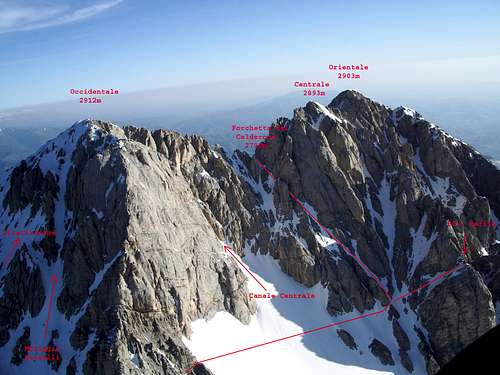 Corno Grande south-east side, with the main routes (by as)
Corno Grande south-east side, with the main routes (by as)
Eastern Chain
The Eastern Chain starts from Vado di Corno saddle and ends at Vado di Sole pass. It’s a huge wall, impressive and high on the north side, harsh and desolate on the south, long more than 15km. It’s very interesting for mountaineers and especially for hikers: along the whole ridge of this long chain runs Sentiero del Centenario Trail, an amazing path with many stretches of Via Ferrata and easy climbing passages.
North side and south side of Eastern Chain are very different: the north side, towering over the Teramo hills, is green, with beautiful woods, while on the south side, rising over the lonely plateau of Campo Imperatore, there aren’t trees, but several screes and couloirs.
The western summit of this subgroup is Monte Brancastello (2385m), a grassy and not so interesting mount. On east of Monte Brancastello there’s the important saddle Vado del Piaverano (2200m).
From Vado del Piaverano, a long and rocky ridge runs from east to west; along this ridge we found some little but interesting mountains: Torri di Casanova (2362m). Torri di Casanova are three stocky towers of rock, climbed by a short but nice Via Ferrata (Via Giovanni Familiari) belonging to the long Sentiero del Centenario Trail. On the east of Torri di Casanova, we meet another interesting mountain: Monte Infornace (2469m), a rocky peak ploughed on its south side by beautiful and easy couloirs, covered in snow for much part of the year.
The rocky ridge continues to the summit of Monte Prena (2561m); this is a beautiful and strange mountain: on its ridges rise many towers, pinnacles and needles and, while the north side presents steeps and wide grassy valley , on its south side secondary rocky ridges and rivers of gravels descend toward Campo Imperatore pastures. There’s no mountains in the Appennines (but I don’t see neither in the Alps) looking like Monte Prena!
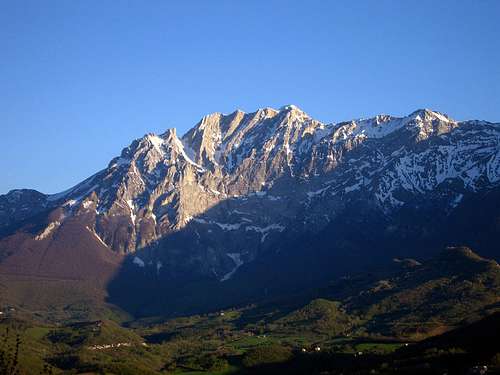 Monte Camicia north face (by as)
Monte Camicia north face (by as)
Continuing toward east, we meet the highest mountain of the chain: Monte Camicia (2564m). Monte Camicia is an important mountain, with two different sides: the south side, visible from Campo Imperatore, with its slopes of grass and gravel and little cliffs of rock isn’t appealing... But the north side is an amazing and steep rock face, 1200m high and 2Km wide, the biggest one after Corno Grande east face! This scary and huge rock wall, very hard to climb because of the bad rock quality, is called by mountaineers of central Italy “our little Eiger” and is climbed very rarely because of the danger of its routes. Belongs to Monte Camicia the odd spur Dente del Lupo (2297m): this sharpened peak, which name in italian means “Wolf’s tooth”, has some interesting climbing route and a beautiful look.
On the east of Dente del Lupo is placed Monte Tremoggia (2350m), a big green mountain, not so interesting.
After Monte Tremoggia, the Eastern Chain ends with some minor mountains: Monte Siella (2027m), Monte San Vito (1892m), Monte Guardiola (1808m). These summits haven’t interest for mountaineers, while they can be a good destination for hikers, because of the beautiful view that you can see from their tops.
On the east of Monte Guardiola, the Vado di Siella pass (1621m) is the eastern border of Gran Sasso range.
More pictures of this subgroup in the Eastern Chain and Campo Imperatore Album
Campo Imperatore and its mountains
“Campo Imperatore potrebbe benissimo essere Tibet. Ricorda la pianura sconfinata di Phari Dzong, a 4200 metri, sulla via tra l’India e Lhasa”
“Campo Imperatore could well be situated in Tibet. It remembers the endless plain of Phari Dzong, at 4200 meters of height, on the way between India and Lhasa”: so wrote in 1933 Fosco Maraini, great writer, ethnologist, explorer and mountaineer.
In fact, the vast plain of Campo Imperatore is a special place: long 20Km, situated at an elevation between 1500m and 2100m, surrounded by high mountains, it’s a unique site in Italy and in the rest of Europe.
This “Little Tibet” is covered by vast meadows, without trees, like a steppe. Is a very fascinating place and, although it’s crossed by a road, it gives a real impression of wilderness; in fact, in winter, this flatland is covered by meters of snow and often striked by storms and fog: if you are caught in that situation, it could be very hard make you safe... In october 1919 the shepard Pupo Nunzio from Roio died wit his two little sons, caught by an unexpected snow storm. Campo Imperatore is also known, in fact, for its harsh climate: every year televisions and newspapers announce the very low temperatures recorded there, with peaks of –20°C/-25°C pratically every year, that, for a mountain placed in the heart of Mediterranean sea, are not so mild...
The northern border of Campo Imperatore coincides with the Eastern Chain; at south, some minor mountains separates this plateau from the bowl of L’Aquila: they are, from the west to the east, Monte della Scindarella (2233m), Monte Cristo (1928m), Cima di Monte Bolza (1927m) and Monte Bolza (1904m). These mountains haven’t interest for mountaineers, but they can be appealing for hikers, because of their vast panoramas, especially Monte Bolza, a beautiful looking mountain above the fascinating town of Castel del Monte. Unfortunately, some of these mounts are partially disfigured by skilifts and chairlifts.
More pictures of this subgroup in the Eastern Chain and Campo Imperatore Album
Calderone Glacier: a frozen jewel, hidden among wild rock summits
Calderone Glacier deserves an own chapter: this little glacier, in fact, is a real gem set among the formidable summits of Corno Grande, in an amazing scenery, unique in the whole Apennine. Calderone Glacier lies in a bowl, covering a north exposed slope, surrounded by high rock walls that overshadow it, delaying the melting of the snow.
It’s a geological rarity, and a geosite of international relevance: in fact, it’s reckoned as the more southern glacier in Europe (42° lat N), since in 1913 the Corral del Veleta glacier, in Sierra Nevada, Andalusia, Spain (37° lat N), was declared definitely extincted by glaciologists. Unfortunely, in not so many years, Calderone will vanish too: already nowadays its glacial mass is very reduced and splitted in two parts, and some geologists think that it’s become a glacieret, that is a buildup of ice and snow, a sort of dying glacier.
Calderone Glacier is placed at an elevation between 2630m and 2867m, its lenght is of about 300m and its surface measures about 4 hectares. The average inclination is of 26°, with a maximum of 50° in the highest part. The glacier is mainly feed by the snowstorms driven by winds from north and north-east, and by the avalanche falling from the surrounding slopes.
Almost the totality of the ice is covered by debris and gravels, so the eminent geologist Claudio Smiraglia defined it as a “black glacier”. Nowadays the maximum thickness of the ice is about 25m, but since not so many years ago it was much more thick: in only 26 years, between 1934 and 1960, it lost 420.000 cubic meters of ice!
Even if we can’t see the ice of Calderone, because of the covering of debris, it’s covered in snow for the most part of the year, so many ski tourers descend it in almost every seasons!
Despite of its smallness and upcoming extinction, it’s very beloved by all the hikers and climbers of central Italy...
Summits over 2000m
|
Gran Sasso from distance
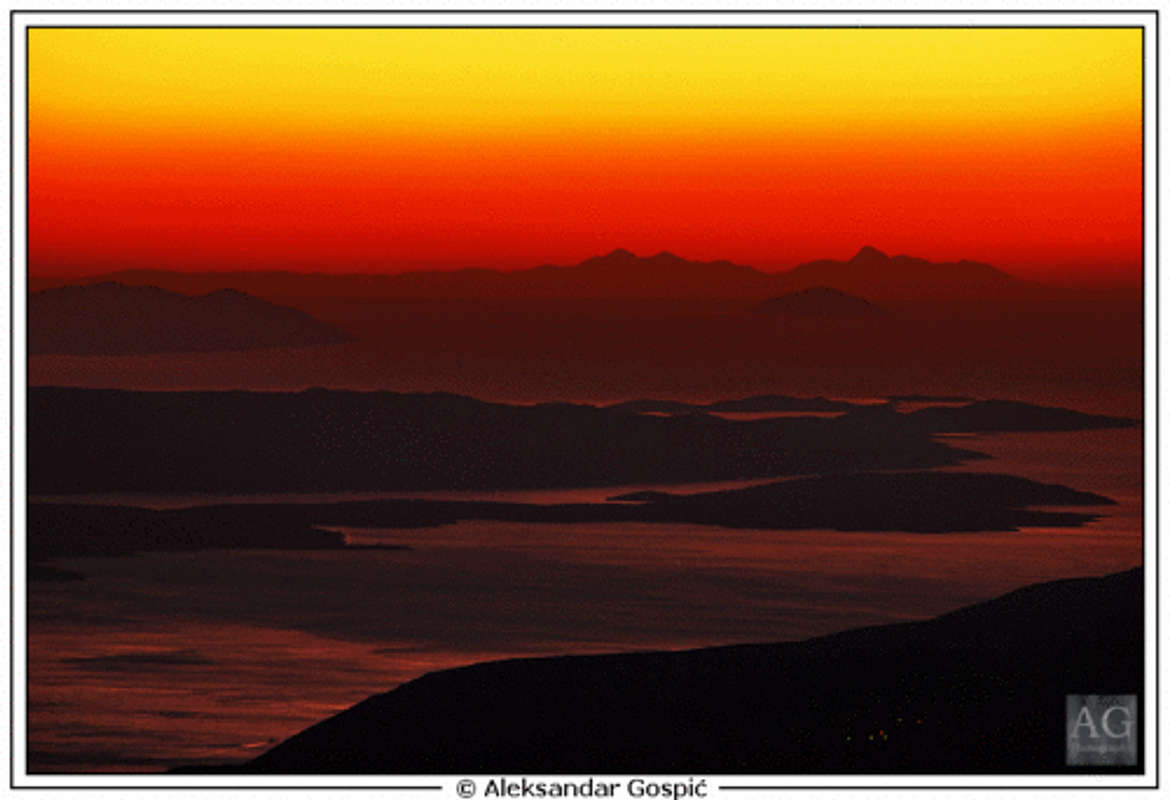 |
A fantastic view of Gran Sasso d'Italia range from Biokovo massif, Croatia, more than 300Km beyond the Adriatic sea! In the picture you can see all the most important summits of the massif. From the left you can see: Monte Camicia Monte Prena Monte Brancastello Vado di Corno Pass Monte Aquila Corno Grande Pizzo d'Intermesoli Monte Corvo (Photo by Velebit) |
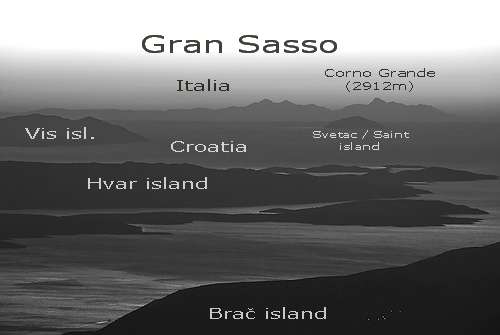 |
In the picture on the left you can see an explanation of the view |
Some naturalistic remarks
Geology
(Based on “Il Gruppo del Gran Sasso – Profilo geomorfologico”, di Domenico Alessandri, in “Gran Sasso le più belle escursioni” di Alberico Alesi, Maurizio Calibani, Antonio Palermi, SER,1996)
Under the geological aspect, the Gran Sasso range is constituted by two main parallel chains: the Northern Chain (from Vado di Sole to Monte Corvo) and the Southern Chain (from Monte Capo di Serre to Monte San Franco), with east to west orientation and splitted by a wide median depression; this depression is, in turn, splitted by three transversal walls in four distinct basins: the former glacial cirques of Campo Imperatore, Campo Pericoli, Venacquaro bowl and Valle del Chiarino.
While the Northern Chain is divided in two parts by the deep Valleys of Venacquaro and Val Maone, the Southern Chain is more continuous and partitioned by few wide and not so deep saddles.
The rocks of these mountains are of sedimentary nature, and they become to be created in the Mesozoic and Cenozoic era, in a deposit period long about 200 millions of years, in a marine “transition” environment, that is a sea belt (continental escarpment) separating the “continental shelf” (sea area a few meters deep) from the “ocean deep” (sea area very deep).
In the shelt (matching with the part of actual Abruzzo region placed at south of Gran Sasso range), due to the low waters, seaweeds and other organism with a calcareous shell left a sediment of carbonate rocks; in the ocean deep (matching with the actual belt of hills placed at the north of Gran Sasso range) arrived only very thin debris, which left a sediment of sandstones and marl rocks; in the area matching with actual Gran Sasso range, instead, materials very different for nature and times of origin, left a various stratigraphical series, made of dolomite rocks, limestone rocks and marl rocks.
At the end of Miocene era (about 6 millions of years ago), due to the tectonics phenomenons relative to the Alpine Orogenesis, started the rising of the Apennine chain and, therefore, of the Gran Sasso range: in different subsequent times, first emerged actual Northern and Southern Chain and were created two deep transversal faults (Val Maone and Valle Venacquaro); in a second phase of “decompression”, were created the actual steep southern slopes of the Northern and Southern Chain, the “median depression” (Campo Imperatore, Campo Pericoli, Valle Venacquaro, Val Chiarino) and the depression delimiting the range on the south (Valle Fredda, Valle del Vasto).
Over this stratigraphical base, since the Quaternarian age (about 600.000 years ago), the terrain-moulding action of glaciers, carsism, and other atmospheric agents had give the actual look to the mountains of Gran Sasso range.
|
The big collapse of IV pillars of Corno Grande Eastern summit in 2006 (picture posted by as)
|
Flora
Gran Sasso’s vegetation, due to its altitude, presents some features quite similar to those of the Alps, but with many Balkanic influences and some interesting endemic species.
Gran Sasso’s flora is, naturally, influenced by the local climate, by the orography and the geology of the range; we can, in fact, identify two areas: the northern side, exposed to the northern and eastern streams, with a humider, oceanic character climate; the southern side, with an arider climate and a continental character, receives less precipitations and is subjected to larger termal excursions.
Another element which influences the climate, and in consequence the vegetation of Gran Sasso range is the presence of valleys, flowing toward the north, and internal bowls: the valleys (Val Maone, Valle Venacquaro, Valle Chiarino) are cool and wooded, while the bowls, placed at a higher altitude, have an harsher climate and a grassy vegetation; in these interesting basins (Campo Pericoli, Venacquaro) there are many of the most interesting species of the range (many endemic species).
The northern side offers a sub-oceanic vegetation, with large woods of beech (fagus sylvatica); in the south side, instead, the dryer climate and the calcareous soil (more porous) offer less large forests: the continental character of the climate determines a vegetation more similar to which of the central europe: rare beech woods, presence of Ostrya carpinifolia and oaks (Quercus pubescens, Quercus cerris), like in the forests wich you can find in the Balkan peninsula. A typical example of this kind of woods is “Macchia Grande”, a wood above the town of Assergi.
Always in the south side, over the altitude of 1700/1800m, there are wide prairies: these vast steppic areas are dued to the deforestation, happened since prehistory, with the goal of create the pastures; in recent age, works of reforestation introduced many conifers, long since extinct: larches (Larix decidua), pines (Pinus nigra), firs (Picea excelsa).
In the list below, some species of particular interest:
- Apennininc Edelweiss (Leontopodium nivale)
- Spring Gentian (Gentiana verna)
- Androsace Mathildae
- Apenninic Genepy (Artemisia petrosa subsp.eriartha)
- Viola Magellensis
- Majella Gentian (Gentiana magellensis)
- Salix herbacea
- Dryas octopetala
- Myosotis alpestris
- Fairy’s Thimble (Campanula cochlearifolia)
- Saxifraga paniculata
- Silene acaule
- Juniperus nana
- Vaccinum myrtillus
- Beech (Fagus sylvatica)
- Black pine (Pinus nigra)
- Red Fir (Abies excelsa)
- White Fir (Abies alba)
- Larch (Larix decidua)
Fauna
In Gran Sasso range we can find a large variety of animal species, even if there are not a so large number of specimens. In the last decades, the creation of Gran Sasso and Monti della Laga National Park permitted the reintroductions of Abruzzi Chamoises (Rupicapra ornata) in 1992 and of Red Deers (Cervus elaphus) in 2004; those beautiful animals were extincted since the end of 19th century, because of a ruthless hunting.
The protection of environment allowed the spontaneous return of Marsicano Bear (Ursus arctos marsicanus), a very rare subspecies of Brown Bear, who lives only in the mountains of Abruzzo region, survived from extinction thanks to the “nature sanctuary” of Abruzzo, Lazio and Molise National Park. Also Apenninic Wolf (Canis lupus italicus), for centuries persecuted by hunters and shepherds, today is more numerous in the Gran Sasso range, thanks to the protection of the National Park.
Among birds, some very important species present in Gran Sasso range are Golden Eagle (Aquila chrysaetos), presents with 5 couples, Peregrine Falcon (Falco peregrinus) presents with 15 couples, and the rare Red-billed Chough (Phyrrocorax phyrrocorax).
Among reptiles, it is to be remarked the presence of Ursini Viper (Vipera ursinii), a little and few poisonous viper, presents, in Italy, only in Abruzzo mountains.
Below, a list of most relevant species living in Gran Sasso d’Italia range:
List of mammals species:
- Abruzzi Chamois (Rupicapra ornata)
- Marsican Brown Bear (Ursus arctos marsicano)
- Apenninic Wolf (Canis lupus italicus)
- Red Deer (Cervus elaphus)
- European Roe Deer (Capreolus capreolus)
- Red Fox (Vulpes vulpes)
- Wild Cat (Felix sylvestris)
- Southern Red Squirrel (Sciurus vulgaris meridionalis)
- Crested Porcupine (Hystrix cristata)
- European Badger (Meles meles)
- Beech Marten (Martes foina)
- Least Weasel (Mustela nivalis)
- Polecat (Mustela putorious)
- Dormouse (Myoxus glis)
List of bird species:
- Golden Eagle (Aquila chrysaetos)
- Common Buzzard (Buteo buteo)
- Short toed Eagle (Circaetus gallicus)
- Eagle Howl (Bubo bubo)
- Peregrine Falcon (Falco peregrinus)
- Northern Raven (Corvus corax)
- Alpine Chough (Pyrrhocorax graculus)
- Red-billed Chough (Pyrrhocorax pyrrhocorax);
- White-winged Snowfinch (Montifrigilla nivalis).
List of reptile species:
- Orsini Viper (Vipera ursinii)
- Asp Viper (Vipera aspis)
- Smooth Snake (Coronella austriaca)
Climate
Due to the west-east orientation of the range, there are relevant differences between the climate of northern side and southern side: the northern side, because of the influence of the near Adriatic sea (about 45Km), is more rainy and is subjected to less harsh temperatures; the southern side, instead, has a more continental climate, with less precipitations and larger termal excursions. On both sides, the most cold month is january, while the warmest are july and august. One of the most important elements is the wind: it blows, on the average, 230 days for year (300 days for year on Corno Grande), 56 of which with a speed of over 54 Km/h, but often over 120 Km/h, with tops of 160 Km/h. The main direction the wind blows from is south west, but often, in winter, it can blows from north east.
Climbers and hikers must consider the wind effects, especially in winter: in Gran Sasso range the wind is often very strong, more than in the internal area of the Alps (like Dolomites, for example); that could be dangerous, because the blows could cause the persons to lose the balance and, above all, because of the wind chill factor: a temperature of –10°C (common in winter) with a wind speed of 60Km/h give a sensation of cold like a temperature of –30°C... Over 2000/2500m, snow covering, usually, lasts from november to early may, depending on the place and positions: in Calderone glacier bowl, in Conca dell’Oro bowl (the site where is placed Garibaldi Hut), and in many other places, we can find commonly, in early spring, a build-up of snow higher than 7/10m; thanks to avalanche alimentation and to the high steep slopes that overshadow it, in Gran Sasso range we can found also one of the most low-altitude permanent snowfields of the whole Apennine chain: the Fondo della Salsa snowfield, placed under the north face of Monte Camicia, at an altitude of only 1100m!
The several high-altitude bowls and plains (es. Campo Pericoli, Campo Imperatore), in winter are often subjected to thermal inversion: in particular conditions, thanks to thermal inversion and albedo effect, the temperatures in these places can easily reach –25°C. Across the board, we can say that Gran Sasso has a mediterranean climate at the lower altitudes, but an alpine climate at the higher, with cold and snowy winters and fresh summers
Getting there
The most important accesses to Gran Sasso range are Prati di Tivo, on the northern side, Campo Imperatore, on the southern side.
- Prati di Tivo: is the best access for the climbs on Corno Piccolo, Pizzo Intermesoli Pillars, Corno Grande North and East side. You can reach Prati di Tivo by car from L’Aquila or Teramo (easily accessible cities) taking A24 highway until the station of S.Gabriele-Colledara. Then exit from highway and take the route ss491 to Montorio al Vomano. When you reach Montorio, take the route ss80 until you reach the crossing to Pietracamela and Prati di Tivo: follow the indication and you reach it (about 70 Km from L’Aquila, 30 from Teramo)
- Campo Imperatore: is the best access for the climbs on Corno Grande South side and is good for the IV and V Pizzo d’Intermesoli Pillars too. You can reach Campo Imperatore by car from L’Aquila or Teramo taking A24 highway until the station of Assergi. Then, follow the route s.s. 17bis to Campo Imperatore -at the crossing follow the signals to “Albergo Campo Imperatore”- (about 45Km from L’Aquila, 70Km from Teramo). Campo Imperatore is also reachable by cableway from Fonte Cerreto (3Km from highway exit), but keep in mind the timetable (last course at 17.00). In winter, when the route is closed because of snow, the cableway is the only way to reach this starting point.
Prati di Tivo is linked to Teramo with a bus service and from L’Aquila you can reach Fonte Cerreto (cableway station) by bus: Site of ARPA, Abruzzo region bus service
The nearest international airport to L’Aquila and Teramo are:
Pescara Airport, Rome Ciampino Airport, Rome Fiumicino Airport.
Accomodation
In the Gran Sasso area there aren’t many campings, and they are placed mainly in the south side (province of L’Aquila). Hotels and B&B are more, but often quite expensive... Good accomodations can be the so called Agriturismo (a kind of farm holidays accomodations), where you can eat and rest well with a right expense. In the links below, you can find some info:
- Prati di Tivo (north side) Hotels
- Castel del Monte (south side) Hotels
- Hotels in Gran Sasso-monti della Laga National Park
- Camping Funivia del Gran Sasso - Fonte Cerreto (south side)
Huts and bivak
In comparison to the extension of the group, we can say that in the Gran Sasso range huts and bivaks are few, especially if comparated to the Alps. However, Gran Sasso is the Apenninic range with more huts, and the first one (Rifugio Garibaldi) was built in 1886!
| Name | Height | Owner | Open | Tel. |
|---|---|---|---|---|
| Biv. Bafile | 2669m | Cai L'Aquila | Always opened | +39 086224342 (Cai L'Aquila) |
| Rif. D'Arcangelo | 1665m | Cai Isola del Gran Sasso | You can get keys at Cai Isola del Gran Sasso | +39 0861 975450 (Cai Isola) |
| Rif. Del Monte | 1614m | Municipality of Fano Adriano | Always opened, no beds | - |
| Rif. Duca degli Abruzzi | 2338m | Cai Roma | June-September | +39 347 9309946 (manager: Emanuela Pivetta) |
| Rif. Forestale Fonte Vetica | 1633m | Cfs/Cai Penne | You can get keys at Cai Penne | +39 0858270151 (Cai Penne) |
| Rif. Franchetti | 2433m | Cai Roma | June-September | +39 0861959634/+39 3332324474 (manager: Luca Mazzoleni) |
| Rif. Garibaldi | 2230m | Cai L'Aquila | On demand - Winter room always opened | +39 3476106450 (manager: Davide De Carolis) |
| Rif. Panepucci-Alessandri | 1600m | Cai L'Aquila | You can get the keys at Cai L'Aquila | +39 086224342 (Cai L'Aquila) |
Red Tape
Gran Sasso d’Italia range is located within the Gran Sasso e Monti della Laga National Park, a wide and wonderful area instituted in 1993 to protect 150.000 ha of woods, pastures and rocks.
In the protected area no fees are dued, no access permits are required, but free camping is not allowed (you need a special permit) and you have to respect the rules for environment protection in force in the Park. In particular, all users of the Park are asked to stay on marked trails to protect against erosion, moreover the Park can temporarily forbid the access to trails and climbing routes to protect particular areas (but these kind of measures are very rare...).
Some roads are closed in winter because of snow, like the road that links Fonte Cerreto with Campo Imperatore Hotel: for this route it is said that will be closed in summer too, with the institution of a shutttle service from the junction with the road to Fonte Vetica to the Campo Imperatore Hotel. The measure, that would have had to be adopted last summer (2007), wasn’t taken still today...
Alpinistic History
Gran Sasso range, because of its distance from Alps, was for a long time a bit behind with the development of Alpinism compared with the more known alpine massifs. Until the XX century, reach Gran Sasso was very difficult due to the lack of railways and roads: from Rome, the more populous city in the nearby, it took three days for about 100 km beeline!
This separation from the centres of mountaineering culture and the lack of a wide basin of climbers, involved the development of an alpinistic movement with own characteristic: sure, at the start, it had a lower technical level in comparison with the Alps, but the protagonists of climbing in Gran Sasso were always men and women of great value and courage, animated by a great passion for their mountains...
I’ll seek to tell you a brief history of this world, without the pretention to be exhaustive: I apologize for all the omissions and possible mistakes. I’ll tell you the facts and characters that, in my humble opinions, are the more relevant. I knew them reading in books and magazines or hearing in the narration by other climbers...
“Prehistoric” climbing (from XVI to XVIII century)
As I told in the introduction of this chapter, mountaineering in Gran Sasso range was for a long time behind compared with Alps, but the first historical attestation of a climb of Corno Grande, the highest mountain of Gran Sasso range and of the whole Apennine chain, is dated 1573!
First known climber of Corno Grande (it’s probable that chamois-hunters reached the summit before him, but they didn’t leave traces of their climbs...) is the captain Francesco De Marchi: he was a man of great genius and curiosity, tipycal son of his age (the Renaissance). He was a soldier in the service of the Medici family and, for his duty, he lived in the city of L’Aquila, at the feet of Gran Sasso range. His climb was only a long and demanding hike, but it’s relevant because it wasn’t motivated by scientific, military or religious intents, but only by the will of climb an high and diffcoult mountain!
For a long time after the first climb, we haven’t notice of other climbs in Gran Sasso... The memory of the feat of De Marchi was completely lost, when in 1794 Orazio Delfico, from Teramo, first climbed the Corno Grande Eastern summit. The Eastern summit is few meters lower than the Western summit, climbed by De Marchi, but the difference in height is very difficult to estimate... Delfico was a scientist, and his climb was motivated by scientific purposes: probably he was inspired by Horace Benedicte de Saussure, the swiss scientist that attempted the climb of Mont Blanc in 1785. Delfico took with him, on the summit, barometers, termometers and other tools to make scientific measurements.
- 19th of august 1573: Francesco DE MARCHI, with the hunter Francesco DI DOMENICO from Assergi and others, reach the Western summit of Corno Grande (2912m)
- 29th of july 1794: Orazio DELFICO, with hunters and shepards from Ornano, reach the Corno Grande-Eastern summit(2903m)
The age of pioneers: the first climbers (XIX century)
It’s only in the last decades of XIX century that true mountaineers appear in Gran Sasso range.In 1875 the british mountaineer Douglas William Freshfield, with the guide from Camonix Francois Devouassoud, climb Corno Grande Western summit from Casale San Nicola, on the northern side, passing through the Calderone glacier. He was amazed by the majesty of that great mountain, and wrote a trip report on the Alpine journal.
With the unification of Italy, in 1871 the capital was finally transferred from Turin to Rome: many politics, public officers and employers came from northern Italy to the Eternal City and many of them brought their passion for mounatineering: Turin, in fact, is a big city near the Alps and its “intelectual elite”, in 1863, founded CAI (Club Alpino Italiano), the first and most important mountaineering association in Italy.
We can say that, as a consequence of the transfer of the Government from Turin to Rome, the italian mountaineering came closer to Gran Sasso!
In 1873 was founded the CAI section of Rome: the members were mainly politics, statesmen, military officers and office bearers coming from Alpine regions of Italy, like Corradino and Gaudenzio Sella, nephews of famous Quintino Sella, founder of CAI and finance minister in many cabinets.
Corradino and Gaudenzio Sella were skilled mountaineers: they known Western Alps very well and they were author of important ascents, like the first climb of Dent du Geant, in Mont Blanc range. Their main climb in Gran Sasso was the first winter ascent of Corno Grande, in the january of 1870: they reached the summit without great troubles, but this was the first “real” climb in Gran Sasso range and in the whole Apennines! They were very pleased by the exploit and compared the winter climbs in Gran Sasso range with the beautiest climbs in the Alps.
Corradino and Gaudenzio Sella, in their first winter climb of Corno Grande, gone with two guides from Assergi: Giovanni Acitelli and a certain Zaccaria. The two mountain dwellers, scared by the winter conditions of the mountain, stopped at the start of the steeper icy slopes: despite of their great knowledge of the mountain, they weren’t used to frequent it in winter, with snow and ice!
Giovanni Acitelli took his revenge some years later, in 1887: with Enrico Abbate from Rome, he climbed first time Corno Piccolo, the rocky peak until then considered unclimbable.
In 1892, with Orlando Gualerzi, Acitelli climbed Corno Grande Central summit and, always with Gualerzi, Abbate and Carlo Ignazio Gravini, in 1892, opened the most famous route on Corno Grande: the Direttissima, on the south side.
In february of 1893, the same group of climbers made the first winter ascent of Corno Piccolo and in 1895 the first winter climb of Corno Grande Eastern summit.
Giovanni Acitelli, from Assergi, was the first real guide of Gran Sasso range, and, after the first failure with Corradino and Gaudenzio Sella, led the “lords” from Rome to the conquest of the more important summits of the range.
- May 1876: Douglas William FRESHFIELD and Francois DEVOUASSOUD climb Corno Grande from Casale San Nicola
- 9th of january 1880: Corradino and Gaudenzio SELLA made the first winter climb of Corno Grande
- 8th of september 1887: Giovanni ACITELLI and Paolo ABBATE first climb Corno Piccolo
- 18th of august 1892: Giovanni ACITELLI and Orlando GUALERZI climb first time Corno Grande Central summit
- 26th of august 1892: Giovanni ACITELLI, Orlando GUALERZI, Carlo Ignazio GRAVINI and Vittorio REBAUDI climb Direttissima, on Corno Grande south face
- 8th of February 1893: Giovanni ACITELLI, Enrico ABBATE, Orlando GUALERZI and Carlo Ignazio GRAVINI made the first winter ascent of Corno Piccolo
- 23rd of march 1895: Giovanni ACITELLI, Orlando GUALERZI and Emilio SCIFONI made the first winter ascent of Corno Grande Eastern summit
The first technical climbs (from 1910 to 1934)
 Aquilotti from Pietracamela, a local climber team founded in 1925 (before Scoiattoli from Cortina and Ragni di Lecco!)
Aquilotti from Pietracamela, a local climber team founded in 1925 (before Scoiattoli from Cortina and Ragni di Lecco!)At the end of XIX century, the Gran Sasso range is frequented by mountaineers: but, while in the Alps climbers passed difficulties on rock until grade IV+, in Gran Sasso climbers didn’t face passes over II+...
In 1910 two Austrian climbers, Schmidt and Riebeling, made the traverse of the ridges of Corno Grande four summits, facing passages of III grade.
The foundation of the University section of Alpine Club (SUCAI), in Rome, brought new contributes to the evolution of mountaineering in the massif.
Major characters of this period are Francesco Acitelli, guide from Assergi, Enrico Jannetta from Rome and Aldo Bonacossa from Milan.
Enrico Jannetta, member of the University section of Alpine Club of Rome, partecipated to the WW I as officer of the Alpini Corp (mountain troops): he fought in the Dolomites, in the area of Cima Undici and Croda Rossa (Sexten Dolomiten) and there he learned the climbing technique that he never couldn’t learn in the restricted Apenninic climbing community...
When he came back to Rome, after the war, he had the experience to become the strongest climber in Apennine: from 1919 to 1922 he climbed Torrione Cambi, Corno Piccolo east face and the huge and scary Paretone, the great eastern face of Corno Grande, high more than 1400m!
With the count Aldo Bonacossa, a nobleman from Milan felt in love with central Apennine, Jannetta climbed many important routes on Corno Piccolo.
The count Bonacossa is important in the alpinistic history of Gran Sasso for two more reasons: he introduced first time ski-touring in the Apennines, and he led on Gran Sasso Giusto Gervasutti, one of the greatest mountaineers of that time, who opened on Corno Piccolo the first route of grade VI of all the range.
We can’t forgot two climbers of those years: Mario Cambi and Paolo Emilio Cichetti. They were two young members of SUCAI of Rome, who made great climbs, and tragically died in february 1929 during a snow storm, attempting the first winter climb of Berthelet route on Corno Piccolo south ridge.
After this period, in which the most important climbers came all from outside, in 1925, thanks to Ernesto Sivitilli, was founded the first climbing group in a town nearby the Gran Sasso massif: it was the “Aquilotti di Pietracamela” group (Aquilotti, in italian, means little eagle). Pietracamela is a small village at the feet of the Gran Sasso north side and Sivitilli was the doctor of the town: he succeeded to create a strong group of climbers, that explored and attempted many of the unclimbed faces of Gran Sasso. The most important climbers belonging to Aquilotti group were:
Antonio Giancola, who climbed in 1933 Via della Crepa route on Corno Piccolo east face, and in 1934 with Domenico D’Armi from L’Aquila, the Via dei Pulpiti route on Torrione Cambi north face, for many repeaters the first VI grade of Gran Sasso.
Bruno Marsili and Antonio Panza that, in 1934 climbed the wide and scaring Monte Camicia north face: a 1200m high wall of bad rock and vertical grass!
- Summer 1910: SCHMIDT and RIEBELING make the traverse of Corno Grande four summits
- 4th of october 1914: Francesco ACITELLI, with Antonio ALLIEVI and Vittorio Emanuele GALLINA first climb Torrione Cambi
- 30th of july 1919: Enrico JANNETTA and Giuseppe MARCHETTI climb a new route on Torrione Cambi west face: the Jannetta chimney (IV-)
- 19th of july 1922: Enrico JANNETTA, Giulio TAVELLA, Michele BUSIRI, Mario GIANQUINTO, Raffaele ROSSI, and Raffaello MATTIANGELI climb Jannetta route on Corno Grande east face
- 21st of july 1922: Enrico JANNETTA, Michele BUSIRI and Giulio TAVELLA climb first time Corno Piccolo east face
- 1st of november 1923: Enrico JANNETTA and Aldo BONACOSSA first climb Corno Piccolo north-east ridge
- 27th of july 1930: Bruno MARSILI, Ernesto SIVITILLI, Osvaldo TRINETTI, Antonio GIANCOLA and Venturino FRANCHI climb first time Corno Piccolo Seconda Spalla south west face
(IV) - 15th of july 1933: Antonio GIANCOLA and Venturino FRANCHI climb Via della Crepa route on Corno Piccolo east face
- 3rd of augut 1934: Antonio GIANCOLA and Domenico D’ARMI climb Via dei Pulpiti route on Torrione Cambi north face
- 2nd of october 1934: Giusto GERVASUTTI and Aldo BONACOSSA climb a route on south face of Corno Piccolo-Punta dei Due: this route contends to Via dei Pulpiti the primacy of first VI grade of Gran Sasso
- 19th of september 1934: Bruno MARSILI and Antonio PANZA first climb Monte Camicia north face (V, 2000m of development, very bad rock)
The University climbers age (from 1946 to 1960)
After the pause imposed by WW II, mountaineering restarted in Europe and in Gran Sasso range too. The main protagonists of this renaissance are a group of climbers of Rome, members of the SUCAI, the University section of Alpine Club of Italy. These boys brought in Gran Sasso their experiences, honed climbing mountains all over the world (but particularly in Dolomites) and their contribution to the mountaineering culture of the massif was a real breackthrough!
They introduced the more advanced technique used in the Alps and their courage and passion boosted the level of climbing in Gran Sasso range. The most important climbers belonging to SUCAI of Rome were Paolo Consiglio, Silvio Jovane, Franco Alletto, Franco Cravino, Dado Morandi. They climbed new routes on the faces of Corno Grande and Corno Piccolo, reaching the VI grade and facing hard difficoulties in aid climbing. Amongst their greatest realizations we can remember: Diretta route on the Corno Grande-Western summit east face, Gran Placca route on Torrione Cambi, Corno Grande-Eastern summit south east ridge, Monolito route on Corno Piccolo east face and many others...
Another important climber of this period was Gigi Mario: he’s a great personage, a bit eccentric (he is an alpine guide, a ski teacher and... a zen priest), but an outstanding mountaineer; with Emilio Caruso he made many important ascents, mainly on Paretone and on Corno Piccolo east face.
- 5th of august 1946: Andrea and Carlo BAFILE from L’Aquila, with Valeria BOSCHERO from Rome, climb Valeria route on Corno Piccolo Campanile Livia: this route is very simple, but very pleasant and very popular among all climbers of central Italy
- 27th of september 1948: Andrea BAFILE, Guglielmo DEL VECCHIO and Piero ZACCARIA from Trieste climb Via dei Triestini route on Campanile Livia
- 3rd of september 1954: Paolo CONSIGLIO, Sigfrido AMODEO, Gian Carlo CASTELLI and Roberto CARPI climb Diretta Consiglio route on the Corno Grande-Western summit east face (VI, A2)
- 7th of october 1956: Franco CRAVINO and Silvio JOVANE (SUCAI of Rome) with Lino D’ANGELO (Aquilotti di Pietracamela group) climb Monolito route on Corno Piccolo east face (V, A2)
- 8th of september 1957: Paolo CONSIGLIO and Franco ALLETTO climb the south west ridge of Corno Grande-Eastern summit (V, A2)
- 2nd of june 1958: Silvio JOVANE and Gigi MARIO climb the 2nd pillar of Corno Grande-Eastern summit east face
- 11th of august 1958: Lino D’ANGELO and Clorindo NARDUCCI climb the 3rd pillar of Corno Grande-Eastern summit east face
- 14th of september 1958: Franco ALLETTO, Gigi MARIO and Emilio CARUSO climb east face of Corno Grande-Eastern summit Anticima Nord
- 5th of july 1959: Gigi MARIO and Emilio CARUSO climb Spigolo a destra della Crepa route, on Corno Piccolo east face (VI, A2)
- 29th of february 1960: Carlo Alberto PINELLI, Silvio JOVANE, Franco CRAVINO and Mario LOPRIORE make the first winter ascent of Jannetta route on Corno Grande-Eastern summit
Ascolani break in, Aquilotti come back (from 1960 to 1975)
In the first years of 60ies, Gigi Mario is still the hero: in 1963 he climbed the route Rosy on Monolito, crossing vertical slabs and hangovers, using bolt and aid climbing.
In 1958 was founded the GAP (Gruppo Alpinisti Piceni), a group gathering strong climbers from Ascoli Piceno. Climbers belonging to GAP were young and very skilled, politically left-oriented: their revolutionary ideal influenced their way to climb mountains and we can find a trace of it in the name they gave to some route on Corno Piccolo north face (Che Guevara and Iskra). The most important members of GAP were Marco Florio, Giuseppe Saladini, Giuseppe Fanesi, Francesco Bachetti, Maurizio Calibani. Some of their most relevant climbs were the first winter ascent of Corno Grande-Eastern summit north ridge, the route Amighetti on the III Pillar of Pizzo Intermesoli, and dozens of routes of medium-high difficulties opened in free climbing.
At the beginning of 70ies Aquilotti di Pietracamela came back on stage with Lino D’Angelo and Enrico De Luca: they made several hard climbs, mainly on Corno Piccolo, opening several new routes.
In 1974 we must remember a great but tragic climb: Domenico Alessandri, Piergiorgio De Paulis and Carlo Leone, all coming from L’Aquila, made the first winter climb of Monte Camicia north face: unfortunately, during the ascent, Piergiorgio De Paulis, only 20 years old, fell and died.
- 4th of august 1963: Gigi MARIO and Giancarlo DOLFI climb Rosy route on Corno Piccolo Monolito (VII+, A)
- 17th and 18th of march 1963: Antonio CALIBANI and Marco FLORIO made the first winter ascent of Corno Grande-Eastern summit north ridge
- 15th of september 1968: Marco FLORIO, Fernando DI FILIPPO, Francesco SALADINI, Salvatore TIRABOVI and Giancarlo TOSTI climb Che Guevara route on Corno Piccolo north face (IV+)
- 29th of september 1968: Francesco BACHETTI and Giuseppe FANESI climb Amighetti route on the III Pillar of Pizzo Intermesoli (VI)
- 25th of november 1968: Franco CRAVINO climb on free solo Falco Albino route, on Corno Piccolo-Prima Spalla south face (V)
- 6th of september 1970: Francesco BACHETTI and Giuseppe FANESI climb Bachetti-Fanesi route on the IV Pillar of Pizzo Intermesoli (V)
- 16th of september 1973: Lino D’ANGELO, Enrico DE LUCA and Dario NIBID climb Aquilotti 73 route on Corno Piccolo Monolito (V+, A3)
- 10th of september 1975: Lino D’ANGELO and Enrico DE LUCA climb Aquilotti 75 route on Corno Piccolo-Seconda Spalla south west face (VI, A3)
- 25th of december 1974: Domenico ALESSANDRI, Piergiorgio DE PAULIS, Carlo LEONE first climb in winter the huge Monte Camicia north face: De Paulis died during the climb
The greatest roman climber: Pierluigi Bini (from 1975 to 1979)
Pierluigi Bini is a real outstanding climber, and sure one of strongest climber of all time in central Italy. He comes from Rome, but he didn’t make his great ascents only in the “near” Gran Sasso range: he made great climbs also in Dolomites (first free solo climbs of Fachiri route on Cima Scotoni and of Gogna route on Marmolada south face).
Friend of some of the best european climbers of that time (Manolo, Mariacher), he was very young when climbed, often in free solo, the hardest routes of Gran Sasso (he was only 16 y.o. when climbed in free solo Mario-Di Filippo route on Corno Piccolo-Prima Spalla, grade V+). Thanks to his contribute, the difficoulties of climbing routes in Gran Sasso finally reached the level of the hardest routes of the Alps.
- 16th of june 1975: Pierluigi BINI, at an age of only 16, climbs in free solo Mario-Di Filippo route, on Corno Piccolo-Prima Spalla (V+)
- July 1977: Pier Luigi BINI, Massimo MARCHEGGIANI and Vito PLUMARI, climb Via del Vecchiaccio route on Corno Piccolo-Seconda Spalla south west face: the last pitch, not protected, it’s the first VI+ of all Gran Sasso Range! (VI+)
- August 1978: Pierluigi BINI, Giampaolo PICONE, Beppe ALDINIO climb on Corno Piccolo-Seconda Spalla south face Stefano Tribioli route (VI+);
- Summer 1978: Pierluigi BINI, Angelo MONTI, Giampaolo PICONE and Vito Plumari climb Placche Manitù route on Corno Piccolo-Prima Spalla (VI)
- Summer 1978: Perluigi BINI with Vito PLUMARI climb Placche del Totem on Corno Piccolo-Prima Spalla (VI)
- 18th of september 1978: Pierluigi BINI and Giampaolo PICONE climb Diedro di Mefisto route on Corno Grande-Eastern summit east face (VI)
- 19th of march 1979: Giampiero DI FEDERICO made first winter ascent, on solo, of Via dei Pulpiti, on Corno Grande-Central summit North face (VI)
The VII grade in Gran Sasso (from 1980 to 1992)
In the 80ies, about a decade later in comparison with the Alps, the “barrier” of VII grade is broken in Gran Sasso range too. While in Dolomites and in the rest of the Alps Manolo, Mariacher, Casarotto, Giordani, Koller, Kuran, Cesen, Profit, Berhault and many others make outstanding climbs, the strongest climbers in Gran Sasso are Giampiero Di Federico from Chieti, Paolo Caruso and Massimo Marcheggiani from Rome, Tiziano Cantalamessa from Ascoli Piceno.
Di Federico is a complete mountaineer: Alpine Guide, in 1985 he made the first solo ascent, by a new route, on Hidden Peak-Gasherbrum I (8068m). In Gran Sasso range he made ascent of extreme difficoulties on rock and many first winter climbs, often on solo. One of his greatest climb feat is the “enchainment” of the four pillars of Paretone, soloing and in only 8 hours!
Paolo Caruso is one of the most skilled climbers of central Italy: Alpine Guide, author of a scientific study on the climbing teaching that is become the official text of Italian Alpine Guides Climbing Schools, member of the party that made the first winter ascent of Cerro Torre (1985), he made some of the hardest climbs on the rock walls of Gran Sasso: we can remember the routes Cavalcare la Tigre and Baphomet on Corno Piccolo east face, and Il Nagual e la Farfalla on Corno Grande Eastern summit east face.
Massimo Marcheggiani is a strong mountaineer: he climbed many new routes in Gran Sasso range and many first winter ascents on Paretone, other than several climbing expeditions in Himalaya and Patagonia. He opened the routes Cavalcare la Tigre with Paolo Caruso, Via del Vecchiaccio with Pierluigi Bini, Fulmini e Saette on the hard north east face of Anticima North of Corno Grande.
Tiziano Cantalamessa was an outstanding climber: Alpine Guide, strong both on rock and on ice, he was a mountaineer that didn’t fear to put himself to the test: he was only 19 y.o. when, with Stefano Pagnini made the 5th repetition of Monte Camicia north face, in the summer of 1975, making a new exit variant; always on the north face of the “little Eiger of the Apennines” he made the 2nd winter ascent, after the tragical first climb of 1974... And in 1992, another great climb: the first winter ascent of Diedro di Mefisto route, one of the greatest climb of whole the time in Gran Sasso range. No doubts he was the stronger mountaineer of central Italy in winter climbs! Unfortunately he died, at only 43 y.o, while he was working to protect a road from landslides.
These are, in my opinion, the most interesting figures of climbers of those years, but many other strong climbers are worthy to be mentioned for their activity in Gran Sasso, like Roberto and Giuseppe Barberi, Luca Grazzini, Romolo Vallesi, Sebastiano Labozzetta, Donatello Amore, Alessandro “Jolly” Lamberti, Enrico De Luca, Franchino Franceschi, Andrea Sarchi, Cristiano Delisi, Luca Bucciarelli, Andrea Di Bari, Angelo Monti, Roberto Ciato, Marco Sordini, Giulia Baciocco and many others.
- 5th of february 1982: Tiziano CANTALAMESSA solo climb Aquilotti 79 route on Corno Grande-Eastern summit east face IV pillar (V)
- 30th of january 1982: Fabio DELISI and Massimo MARCHEGGIANI climb Delisi-Marchegiani winter route on Corno Grande-Eastern summit Anticima North northeast face (85°, 1400m)
- 1st of august1982: Giampiero DI FEDERICO and Enrico DE LUCA climb Federico-De Luca route on Pizzo d’Intermesoli-II Pillar south face (VII)
- 4th of july 1982: Paolo CARUSO and Massimo MARCHEGGIANI climb Cavalcare la Tigre on Corno Piccolo east face (VII, A3)
- 4th of september 1982: Paolo ABBATE and Maurizio TACCHI climb new route on Corno Piccolo-Seconda Spalla north face: Icosaedro (VI+, A1)
- 30th of september 1982: Marco FLORIO makes first solo climb of Monte Camicia north face
- Summer 1985: Andrea DI BARI climbs on free-solo La notte delle Streghe on Seconda Spalla (TD, VI-) and Zarahtustra e nonna Iole on Prima Spalla (TD+, VI+)
- Summer 1985: Alessandro “Jolly” LAMBERTI and Luca GRAZZINI climb in only 5 hours Alletto-Caruso route on Corno Grande-Anticima North, Mario-Caruso on Corno Grande-Eastern Summit Paretone (est face) IV pillar and Alessandri-Furi-Leone on III pillar
- 13th of july 1985: Maurizio TACCHI, Paolo ABBATE, Roberto and Giuseppe BARBERI climb Silmarillion route on Pizzo d’Intermesoli-II pillar south face (VII-)
- 22nd-23rd of december 1985: Massimo MARCHEGGIANI climb on solo the north ridge of Corno Grande-Anticima North
- Summer 1986: Pier Luigi BINI and Alvaro DE LIVIO concatenate 9 routes in 6 hours on Corno Piccolo-Seconda Spalla
- Summer 1986: Luca BUCCIARELLI and Cristiano DELISI climb Forza 17 on Pizzo d’Intermesoli-II Pillar south face (VII, A)
- 28th of june and 6th of july 1986: Roberto and Giuseppe BARBERI, Paolo ABBATE, Maurizio TACCHI climb Terminèsoli on Pizzo d’Intermesoli-II Pillar south face (VII+)
- 4th of august 1986: Paolo and Roberto CARUSO climb Baphomet on Corno Piccolo-Monolito (VIII-, A)
- 15th of august 1986: Giampiero DI FEDERICO enchain, on free solo, Jovane-Mario, Mario-Caruso, Diretta Alessandri and Pinelli-Gradi-Lopriore routes on the four Pillars of Corno Grande-Eastern summit east face: 1800m of development with difficulties until VI grade!
- Summer 1987 (8 days not consecutive): Paolo CARUSO, Giulia BACIOCCO, Andrea SARCHI climb Il Nagual e la Farfalla route, on Corno Grande-Eastern summit east face (VIII-, A, bolts)
- 8th of july 1987: Massimo MARCHEGGIANI and Lorenzo BRUNELLI open Fulmini e Saette route on Corno Grande-Anticima North east face (VII)
- 22nd-23rd of december 1987: Tiziano CANTALAMESSA and Franchino FRANCESCHI make the second winter ascent of Monte Camicia north face
- 16th-17th of january 1989: Tiziano CANTALAMESSA, Franchino FRANCESCHI, Massimo MARCHEGGIANI make first winter climb of Martina route on Corno Grande-Eastern summit east face (VI+)
- 30th of july and 18th of august 1989: Roberto IANNILLI and Andrea IMBROSCIANO climb Musica Nova, on Corno Grande-Torrione Cambi south face (VII-)
- 8th of august 1989: Roberto IANNILLI and Andrea IMBROSCIANO climb Il vento dell’Est on Corno Grande-Western summit east face (VII-)
- Summer 1991 (several days): Sebastiano LA BOZZETTA and Luca GRAZZINI climb Di notte la luna… on Pizzo d’Intermesoli-II pillar south face (VII+, A)
- 17th-19th of january 1992: Tiziano CANTALAMESSA and Franchino FRANCESCHI first winter climb Diedro di Mefisto route on Corno Grande-Eastern summit east face (VI)
Recent years (from 1993 to nowadays)
Many climbers made great ascents in the last 15 years: among them, the most interesting and sure one of the most skilled is Roberto Iannilli from Ladispoli, a small coastal town near Rome.
Iannilli is a great mountaineer, mainly able in rock climbing: he climbed more than 100 new routes in Gran Sasso range, most of them of very high difficoulties, often in free, sometimes on solo, and he solo climbed all the hardest routes of Gran Sasso. He made his work all over the rock-walls of the massif, from Corno Grande to Corno Piccolo, from Monte Camicia north face to the Pillars of Pizzo d’Intermesoli.
Among the many great climbs he made, we can remember two ascents, both climbed with Ezio Bartolomei, on the huge and dark north face of Monte Camicia: Pilastro Nirvana, VI+, and Vacanze Romane, 2075m of development, V+ on bad rock...
In the last years, strong mountaineers made great exploits:
- in january 2008 Andrea Di Donato, from Castelli, climbs first time on free-solo and unroped the Monte Camicia North Face, by the Marsili-Panza route;
- in july 2008 Bertrand Lamaire and Roberto Rosica climb first L'erba del Diavolo, a new route on Pizzo Intermesoli 2nd Pillar. The route, actually. is the most hard of the whole range (7b/VIII+)
- in february 2011 Lorenzo Angelozzi, Andrea Di Dontato and Andrea Di Pascasio climb first time in winter the route Fulmini e Saette on north east face of Anticima North of Corno Grande. The climb takes 3 days to these young and very strong mountaineers, with difficulties of VIII UIAA, ice and snow. The climbers dedicated it to Tiziano Cantalamessa memory.
Other mountaineers worthy to be mentioned for their activities in Gran Sasso are: Bruno Vitale, author of several new routes on the slabs of Corno Piccolo and Pizzo d’Intermesoli; Germana Maiolatesi, good climber and extreme skier, that, with Stefano Imperatori, was first to ski most of the steeper couloirs of Gran Sasso; Marco Marziale and Luciano Mastracci, that made several first winter ascents; Fabio Lattavo, Roberto Alloi, Raffaele Parisi, Sandro Momigliano and many others that gave their contribute to make the history of climbing on the walls of Gran Sasso range.
- 16th of january 1993: Paolo DE FABIIS, Marco MARZIALE, Luciano MASTRACCI make the first winter climb of Arrivederci Ragazzi on Corno Piccolo-Terza Spalla west face (VII-)
- 6th of february 1993: Marco MARZIALE and Luciano MASTRACCI make the first winter climb of Cavalcare la Tigre on Corno Piccolo east face (VII, A3)
- Summer 1995: Roberto IANNILLI and R. BESSIO climb La vendetta di Montezuma on Corno Piccolo-Seconda Spalla south face (VIII)
- Summer 1996: Roberto IANNILLI and Alessandro BUCCIARELLI climb Curre Curre Guagliò on Corno Piccolo-Monolito (VIII)
- 16th of March 1997: Marco MARZIALE, Luciano MASTRACCI and Gianluca DE ROSSI make the first winter climb of Il Nagual e la Farfalla, on Corno Grande-Eastern summit east face (VIII-, A)
- Summer 1998: Roberto IANNILLI and Ezio BARTOLOMEI climb Pilastro Nirvana on Monte Camicia north face (VI+)
- 21st and 22nd of august 1999: Roberto IANNILLI and Ezio BARTOLOMEI climb Vacanze Romane on Monte Camicia north face (V+ on bad rock, 2075m of development)
- 8th of august 2002: Roberto IANNILLI first solo climbs Di notte la luna... on Pizzo d’Intermesoli-II Pillar (VII+, A)
- 6th of july 2004: Roberto IANNILLI, on solo, climb Pietro Valpreda route, on Corno Piccolo east face (VII, A2/3)
- 10th of july 2004: Roberto IANNILLI, on solo, climb first the second part of L’eredità di Marco route, on Corno Piccolo east face. This route is dedicated to Marco SORDINI who climbed the first part (VII-, A3+)
- 28th of january 2008: Andrea DI DONATO, climbs first time on free-solo and unroped the Monte Camicia North Face, by the Marsili-Panza route (more than 2000m of development, 1250m of elevation gain, TD- in summer, V UIAA on bad rock). It's the third winter climb of the north face and it took to him only 5h 30min
- 20th of july 2008: Bertrand LAMAIRE and Roberto ROSICA climb first L’erba del Diavolo, on Pizzo Intermesoli 2nd Pillar. This route is the hardest of the whole range (7b/VIII+)
- 10th, 11th, 12th of february 2011: Lorenzo ANGELOZZI, Andrea DI DONATO and Andrea DI PASCASIO climb first time in winter Fulmini e Saette on north east face of Anticima North of Corno Grande
Alpine Rescue
 |
C.N.S.A. ABRUZZO ALPINE RESCUE PHONE NR. 800-258239 |
 |
GUARDIA DI FINANZA ALPINE RESCUE PHONE NR. 117 |
Panorama and sceneries
|
|
|
|
|
|
Movie: "Gran Sasso, la montagna che unisce"
Footage (7 min.) from the movie "Gran Sasso, la montagna che unisce" ("Gran Sasso, the joining mountain")
Books, guides, maps, external links
Books
- L. Grazzini, P. Abbate, Gran Sasso d’Italia, Cai-Tci, 1992
- S. Ardito, A piedi sul Gran Sasso, Iter, 1992
- S. Ardito, A Piedi in Abruzzo vol. 1, Iter, 1996
- A. Alesi, M. Calibani, A. Palermi, Gran Sasso – Le più belle escursioni, SER, 1996
- M. Dell'Omo, I conquistatori del Gran Sasso, Vivalda Editori, 2005
- A. Sciamplicotti, Rotti e stracciati-Aria di Roma sulle cime, CDA
- Stephen Fox, Central Apennines of Italy-Walks, scrambles and climbs, Cicerone Press
Magazines
- ALP monografie "Gran Sasso d’Italia", n. 167, marzo 1999; "Montagne d'Abruzzo", bimestrale anno V nr. 7 (marzo 2009)
- Meridiani montagne "Gran Sasso", n.7, marzo 2004
- L'Appennino, magazine of CAI of Rome, n.3, 1997 (monography) and several news on almost all the numbers
- L'ometto di pietra, magazine of CAI of L'Aquila, many news in almost all the numbers
Maps
- “Gran Sasso d’Italia. La carta dei sentieri”, 1:25000, edited by Cai-L’Aquila
- "Gran Sasso: Atlante dei sentieri - hiking atlas", 1:25000, edited by SER (very useful and convenient: advisable!)
- "Gran Sasso d'Italia - Carta escursionistica", 1:25000, edited by Il Lupo
- "Gran Sasso d'Italia L'Aquila", 1:50000, edited by Kompass
- "Gran Sasso d'Italia - Carta dei sentieri", 1:15000, edited by Technopress
Meteo links
- Avalanche bulletin for the Central Apennines
- Weather condition in Campo Imperatore
- Weather forecast for Campo Imperatore
- Weather forecast for Prati di Tivo
- Weather forecast for Rifugio Franchetti
Live Cams
- Prati di Tivo - 1400m (north side)
- Prato Selva - 1400m (north side)
- Gran Sasso range from Teramo - 265m (north side)
- Gran Sasso range from Canzano - 448m(north side)
- Campo Imperatore: Corno Grande, M. Aquila, M. Portella from M. Scindarella - 2132m (south side)
Alpinistic associations active in Gran Sasso range
- CAI Antrodoco
- CAI Ascoli Piceno
- CAI L'Aquila
- CAI Chieti
- CAI Frascati
- CAI Macerata
- CAI Ortona
- CAI Penne
- CAI Pescara
- CAI Rieti
- CAI Roma
- CAI Teramo
Mountain Guides
A list of links to Mountain Guides associations operating in Gran Sasso range:
- Mountain Evolution
- Abruzzo Mountain Guides
- Collegio Regionale Guide Alpine Abruzzo
- Guida Alpina Giampiero Di Federico
- WildWorld Mountain Experience
Miscellaneous links
- Gran Sasso news (diverse infos about Gran Sasso)
- Climbing in Gran Sasso (excellent site by Guillaume Dargaud with many useful informations about mountaineering in Gran Sasso - in English and French)
- www.lagagransasso.it (very good site with many info about several hikes)
- www.eneafiorentini.it (site of a friend of mine: many very accurate descriptions of vie ferrate, hikes and climbs in several mountain groups, many of them in Gran Sasso range)
- Il Monte Geologo (site with many reports of hikes, climbs and skitours in the Apennines - many of them in Gran Sasso range. Beautiful photo!)
- Gran Sasso - Arrampicate su Roccia (topic dedicated to climbing in Gran Sasso, from the forum Fuori Via - many interesting pictures and infos)
- Vecchie glorie (site that gathers Gran Sasso's old climbers' stories)
- Complete bibliography and iconography about Gran Sasso d'Italia, by Lina Ranalli
- Gran Sasso: Luoghi nelle parole (anthology of literature pieces about Gran Sasso)


